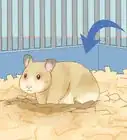This article was co-authored by Pippa Elliott, MRCVS. Dr. Elliott, BVMS, MRCVS is a veterinarian with over 30 years of experience in veterinary surgery and companion animal practice. She graduated from the University of Glasgow in 1987 with a degree in veterinary medicine and surgery. She has worked at the same animal clinic in her hometown for over 20 years.
This article has been viewed 89,098 times.
Hamsters are solitary creatures, and introducing 2 hamsters may lead to aggression. This may result in a fight, which could leave 1 or both hamsters with injuries that may be fatal. However, there are things you can do to increase the chances that your hamsters will get along. Take it slow, ensure that your hamsters have plenty of resources, and be on the lookout for signs of aggression!
Steps
Increasing Your Chances of a Good Outcome
-
1Get hamsters that are the same sex. Having a same-sex pair of hamsters will help to ensure that you do not end up with baby hamsters to care for, and it will also increase the chances that the two hamsters will get along.[1]
- A reputable breeder or a pet shop employee should be able to sex the hamsters for you.
-
2Choose hamsters younger than 2 months old from the same litter or cage. Younger hamsters will be more likely to get along, so buy 2 young hamsters together if possible. This will help to ensure that they are not strangers and will increase the chances that they will get along.[2]
- Do not try to put a young hamster in with an older hamster. The older hamster will be protective of its territory and the hamsters will likely fight.
Tip: Mother and child hamster pairs often do well together, but this may not always be an option.
Advertisement -
3Let the hamsters get used to each other's scent before introducing them. Exchange a bit of bedding between the hamsters' cages. Then, give both hamsters a couple of days to investigate the other hamster's scent before you put them in the same cage.
- Also, keep in mind that if you hold one hamster and then introduce it to a cage with a hamster you have not yet held, then the other hamster may reject that hamster based on the unfamiliar scent. Hold both hamsters before you introduce them to each other so that your scent will be on both of them.
-
1Get a cage that is at least 24 by 24 by 12 in (61 by 61 by 30 cm). This will ensure that your hamsters will have plenty of space to roam and play, and they will be able to get away from each other if needed. You can choose a wire cage or a glass aquarium. However, make sure that the enclosure has a secure lid that will prevent your hamsters from escaping.
- If you choose a glass aquarium, then place a mesh lid on top of it to allow air to flow through since no air will be able to get through the sides.
-
2Move the hamsters to temporary housing while you prepare their shared cage. If you want to house both hamsters in a cage that one hamster has been using, take that hamster out of the cage and put it into a temporary cage.[3]
- If you don’t have two extra cages to place the hamster in temporarily, then put each hamster into a shoe box or hamster ball. However, don’t keep them in these temporary enclosures for more than an hour.
-
3Clean the cage thoroughly before putting them into it. While the hamsters are in their temporary enclosures, remove all of the food, water, toys, and bedding from the cage. Then, use a clean sponge and warm, soapy water to clean the inside of the cage. Dry the cage with a clean towel or paper towel, then fill the cage with new bedding, food, water, and toys.[4]
- Only use bedding that is made from plant-based fibers or cellulose. Never use wood shavings, newspaper, cat litter, corn cobs, or any type of scented bedding.[5]
- Do not try to reuse the old bedding! Throw it out and replace it with new bedding every time you clean your hamster’s cage.
-
4Put extra food and water into the cage. Hamsters are territorial and they will fight if there do not seem to be enough resources. Make sure that there is twice the normal amount of food and water in the cage. Place two food and water bowls on opposite ends of the enclosure for your hamsters.[6]
- Provide specially made hamster food in dishes for your hamsters to graze on and also place fresh slices of fruit and veggies into the cage for them daily, such as carrots, apples, pears, or broccoli.
- Never give your hamster onions, leeks, garlic, chives, lettuce oranges, or raw potatoes because it can make them very sick!
-
5Give the hamsters extra toys, chewing material, and hiding spaces. Buy a few extra toys to place into the cage before you introduce the two hamsters, such as PVC pipes, hamster wheels, and plastic igloos. This will help to keep your hamsters entertained and ensure that they get plenty of exercise. Hamsters also like items that they can chew on, such as hardwood, twigs, or even, dog biscuits.[7]
- Hamsters love to run! If possible, get two hamster wheels so that each of your hamsters will be able to run whenever they like.[8]
Looking for fun new ways to entertain your hamsters? Buy your hamsters some new toys, or create toys for them using household items!
Making the Introduction
-
1Place a mesh or wire divider down the center of the cage. A divider may be a good idea to prevent the hamsters from fighting when they first meet. Use a piece of mesh or chicken wire so that the hamsters can still see and smell each other. Position the divider in the center of the cage and make sure that there are food and water bowls on both sides of the divider.
- You may also be able to purchase a special divider insert for the hamster cage at your local pet store.
-
2Wait until the hamsters are both awake to introduce them. Do not wake them up if they are sleeping because this will make them grouchy! Let the hamsters sleep for as long as they like and then make the introduction after they have woken up naturally.[9]
- Pay attention to when the hamsters normally sleep and wake so that you will know when to attempt the introduction.
-
3Dim the lights in the room. Bright lights may cause the hamsters to feel threatened and this is more likely to result in fighting. Dim the lights in the room where you keep the hamsters.[10]
- For example, you could close the curtains to block out some of the sunlight, or turn off half the lights in the room.
-
4Put the new hamster into the clean cage first. This will reduce the chances that the old hamster will become territorial. Place the old hamster into the cage with the new hamster a minute later. Make sure that they are on separate sides of the barrier!
- You may also use a plastic bin or shoebox to make the introduction. Place the divider down the center of the bin and put adequate bedding, food, and water on each side of the divider.
- If both hamsters are new, place 1 of the hamsters into the cage first, then add the other a minute later.
-
5Remove the divider after a couple of days if the hamsters are getting along. To ensure that the hamsters have a chance to get used to each other, leave the divider in the cage for the first few days. Then, when it seems like they are getting along, remove the divider and watch them closely!
-
6Leave the divider in place if the hamsters are not getting along. If the hamsters do not seem to be getting along, do not remove the divider. Return them to their separate cages and try to introduce them through the barrier again the next day.
- If the hamsters continue to show signs of aggression, you may have to house them separately.
-
7Separate the hamsters if they start to fight. Watch the hamsters closely! They will likely chirp at each other, sniff each other, and they may even wrestle. This is normal. However, if the hamsters start to fight, bite, scratch, or otherwise seem like they are trying to hurt each other, then separate them immediately.[11]
- Even if both hamsters seem to be getting along well, check them both for bites regularly. If you notice bites on 1 or both hamsters, separate them immediately.[12]
- Be prepared to keep your hamsters separated in 2 different cages if they don’t get along.
Tip: If you have an aggressive hamster, you may want to try taming it to help make it more friendly towards you and other hamsters. This may help to ensure that the 2 hamsters get along.
Warnings
- If 1 hamster gets on top of the other hamster and is soundlessly moving in slow motion, separate them immediately and do not try to put them into the same cage again! This behavior indicates that a deadly fight is about to happen and the hamster on top will likely try to kill its cage mate again.[13]⧼thumbs_response⧽
Things You’ll Need
- Hamster enclosure at least 24 by 24 by 12 in (61 by 61 by 30 cm) (width, length, height)
- Sponge
- Water
- Soap
- Towel or paper towels
- Fresh cellulose or plant-based bedding
- Hamster food
- Food and water bowls
- Mesh or chicken wire
References
- ↑ https://www.animalhumanesociety.org/adoption/hamster-care
- ↑ https://www.petmd.com/exotic/care/evr_ex_hm_how-to-care-for-your-hamster
- ↑ http://russiandwarfhamster.org/how-to-introduce-two-russian-dwarfs-together-5-easy-steps/
- ↑ http://russiandwarfhamster.org/how-to-introduce-two-russian-dwarfs-together-5-easy-steps/
- ↑ https://www.petmd.com/exotic/care/evr_ex_hm_how-to-care-for-your-hamster
- ↑ http://russiandwarfhamster.org/how-to-introduce-two-russian-dwarfs-together-5-easy-steps/
- ↑ https://www.animalhumanesociety.org/adoption/hamster-care
- ↑ https://www.petmd.com/exotic/care/evr_ex_hm_how-to-care-for-your-hamster
- ↑ http://russiandwarfhamster.org/how-to-introduce-two-russian-dwarfs-together-5-easy-steps/
- ↑ https://www.petcha.com/keeping-two-or-more-dwarf-hamsters/
- ↑ http://russiandwarfhamster.org/how-to-introduce-two-russian-dwarfs-together-5-easy-steps/
- ↑ https://www.petcha.com/keeping-two-or-more-dwarf-hamsters/
- ↑ http://russiandwarfhamster.org/how-to-introduce-two-russian-dwarfs-together-5-easy-steps/
About This Article
To introduce two dwarf hamsters, place a mesh divider down the center of the cage and place a hamster on each side. Let the hamsters see and smell each other with the divider between them for a few days before letting them interact. Next, wait until both hamsters are awake and dim the lights in the room to create a soothing environment. Then, remove the divider and watch them closely. If they start to fight, replace the divider and try again in a few days. For tips on what to do if the hamsters continue to fight, read on!











































































